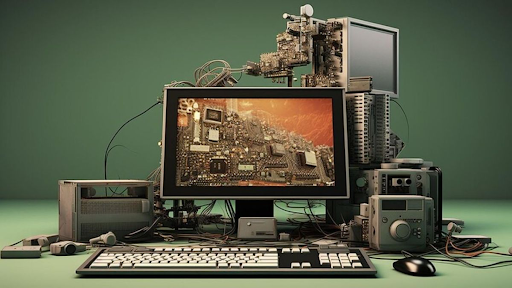Elevate Your Dell Dimension L800R 800EB MHz with These Upgrades
The Dell Dimension L800R 800EB MHz is a timeless piece of technology that has maintained its relevance over the years. Although it may not be the latest model available, there’s something uniquely nostalgic about these older systems. Just because it’s a bit dated doesn’t mean you can’t enhance its performance. By upgrading your L800R, you can transform it into a faster, more efficient machine.
Imagine seamlessly running modern applications or enjoying lag-free gaming sessions. Whether you use it for everyday tasks or more demanding projects, this guide will walk you through how to optimize your Dell Dimension L800R 800EB MHz to meet today’s standards. Let’s dive into the easy and rewarding process of upgrading this iconic device!
Key Parts of Your Dell Dimension L800R 800EB MHz System
Understanding the internal components of your computer is essential before performing any upgrades. Each part plays a crucial role in determining overall performance.
The processor (CPU) is the heart of your machine. It controls all tasks and calculations, so upgrading to a faster processor can significantly improve performance in both everyday use and multitasking.
RAM serves as temporary storage for quick data access. Increasing your system’s RAM can allow for smoother multitasking, helping your computer handle multiple programs at once without slowing down.
When it comes to storage, there are two main types of drives: hard disk drives (HDDs), which use spinning disks, and solid-state drives (SSDs), which utilize flash memory for faster data access and boot times.
For better graphics and sound, upgrading your graphics card and audio card can significantly enhance multimedia performance, especially for gaming or watching videos.
Boosting Your Processor’s Power
Upgrading the processor in your Dell Dimension L800R 800EB MHz is one of the best ways to improve system performance. First, check that the new processor is compatible with your motherboard—ensure the socket type and maximum supported speed match for optimal performance.
A good upgrade would be switching to a faster Intel Pentium III or an early Celeron processor. These options are compatible with the L800R while offering a substantial boost in processing power.
Before starting, be sure to turn off the computer and ground yourself to avoid static damage. Open the case to access the CPU. Carefully release the lever securing the old processor and replace it with the new one, applying thermal paste and attaching a cooler if necessary.
Once reassembled, power up your system and you’ll immediately notice a faster, more responsive machine with quicker load times and enhanced multitasking abilities.
Adding More RAM for a Faster Experience
If your Dell Dimension L800R 800EB MHz feels sluggish during multitasking or when running resource-heavy applications, adding more RAM is a vital upgrade.
Check how much RAM is currently installed on your system. The L800R typically supports up to 512MB of SDRAM in two memory slots. You’ll need to ensure that the new RAM is compatible with your current configuration.
To install additional memory, open the case carefully and ground yourself to avoid static discharge. Once inside, locate the RAM slots and remove any existing modules if necessary. Insert the new RAM sticks firmly into place, making sure they click into position at both ends.
Close the case, restart your computer, and your system should immediately recognize the new memory, resulting in smoother performance and better handling of multiple tasks.
Upgrading to an SSD for Faster Performance
One of the best upgrades for your Dell Dimension L800R 800EB MHz is installing a solid-state drive (SSD). An SSD will drastically improve boot times and provide faster access to applications, making everything feel snappier.
Select an SSD that suits your needs, and ensure it’s compatible with older systems like yours (look for SATA drives). Begin by powering off your computer and disconnecting all cables for safety.
Carefully open the case and locate the hard drive bay. If necessary, remove the existing HDD, then secure the new SSD into place using screws or brackets. Connect it to the motherboard with a SATA cable and attach the power connector from the power supply unit.
Once everything is connected and secured, close the case and power on your system. After installing the operating system on the SSD, you’ll notice a significant improvement in overall system speed.
Enhancing Graphics and Audio Capabilities
Upgrading the graphics and audio components of your Dell Dimension L800R 800EB MHz can breathe new life into the system, enhancing your visual and audio experiences.
For the graphics card, find a compatible model that fits both your needs and your budget. Many entry-level options provide a significant performance boost without requiring too much power, ensuring smooth rendering and better visuals.
The audio card is another worthwhile upgrade. While the integrated sound may be sufficient for basic use, a dedicated audio card will offer superior sound quality, supporting features like surround sound and advanced equalizer settings.
These upgrades not only improve the visuals of your system but also provide a much richer audio experience, making entertainment more immersive.
Key Facts
- Processor: The Dell Dimension L800R 800EB MHz is equipped with an Intel Pentium III processor running at 800 MHz, which was a significant speed for its time, making it suitable for general computing tasks and some light multimedia work.
- Release Date: The Dell Dimension L800R was released in the early 2000s, during a period when Pentium III processors were widely used in personal desktop computers.
- Memory Support: The system typically supports up to 512MB of SDRAM, which was a standard memory size for many computers of its era, although it may be a limiting factor for modern multitasking.
- Storage: The system originally came with traditional hard disk drives (HDDs), with options for different storage capacities. Upgrading to a solid-state drive (SSD) is one of the most impactful improvements for performance.
- Graphics: The Dell Dimension L800R typically used integrated graphics, which were adequate for basic tasks but not ideal for gaming or more graphics-intensive applications. Upgrading the graphics card would significantly improve visual performance.
- Compatibility with Older Software: While it may not handle newer software very efficiently, the L800R is still compatible with older software and can be a solid choice for legacy applications or simple tasks like word processing, browsing, and email.
- Upgradability: Though the machine is old, it can be upgraded to some extent. For example, users can upgrade the processor, add more RAM (up to the supported limit), and replace the HDD with an SSD for better performance.
- Design: The Dell Dimension L800R has a typical early 2000s desktop design, with a beige or black tower that’s relatively compact compared to some older desktop models.
- Use Cases: While it’s not suited for modern, resource-heavy applications, it can still be useful for basic office tasks, lightweight internet browsing, or as a backup or secondary machine for specific legacy applications.
- Operating System: When it was first released, the L800R typically came with Windows 98 or Windows XP. With upgrades, it can still run more modern operating systems like Linux or light versions of Windows.
Final Thoughts: Enjoying the Enhanced Dell Dimension L800R 800EB MHz
By upgrading your Dell Dimension L800R 800EB MHz, you breathe new life into a classic piece of technology. With improvements like a faster processor, more RAM, and an SSD, you’ll experience noticeable performance gains. Don’t forget that upgrading the graphics and audio components will ensure you get the most out of your multimedia experience.
After completing these upgrades, you’ll find that everyday tasks like browsing the web or streaming content will be smoother and faster. Reviving an older system like the Dell Dimension L800R 800EB MHz is a satisfying experience—both because of the technical improvements and the nostalgic value of the machine.
With proper upgrades and careful installation, your Dell Dimension L800R 800EB MHz can continue serving you well for years to come. Whether for work or leisure, you can now enjoy the enhanced performance it brings!
FAQs
1. What is the Dell Dimension L800R 800EB MHz?
The Dell Dimension L800R 800EB MHz is a desktop computer released by Dell in the early 2000s. It is powered by an Intel Pentium III processor running at 800 MHz and was designed for everyday computing tasks at the time, such as word processing, web browsing, and light multimedia use.
2. Can I upgrade the processor in my Dell Dimension L800R 800EB MHz?
Yes, the processor in the Dell Dimension L800R 800EB MHz can be upgraded. It supports Intel Pentium III processors and early Celeron chips. However, make sure to check the motherboard’s compatibility with newer processors before upgrading.
3. What is the maximum amount of RAM the Dell Dimension L800R 800EB MHz can support?
The Dell Dimension L800R 800EB MHz typically supports up to 512MB of SDRAM across its two memory slots. Although this is relatively low by modern standards, upgrading to the maximum supported RAM can help improve its multitasking abilities.
4. How can I improve the speed of my Dell Dimension L800R 800EB MHz?
To boost the performance of your Dell Dimension L800R 800EB MHz, you can upgrade several components:
- Add more RAM to improve multitasking.
- Replace the hard drive with an SSD for faster boot times and quicker access to data.
- Upgrade the processor to a faster Pentium III or early Celeron model.
- Install a dedicated graphics card for better gaming or multimedia performance.
5. What storage options are available for the Dell Dimension L800R 800EB MHz?
The Dell Dimension L800R 800EB MHz originally came with traditional hard disk drives (HDDs). However, you can upgrade it to a solid-state drive (SSD) for significantly faster data access, quicker boot times, and an overall improved system experience.
6. Is the Dell Dimension L800R 800EB MHz compatible with modern operating systems?
While the Dell Dimension L800R 800EB MHz was originally designed to run Windows 98 or Windows XP, it can still run lighter operating systems like Linux or even more modern, stripped-down versions of Windows. However, performance might not be ideal for the latest software due to its older hardware.
7. Can I upgrade the graphics card in the Dell Dimension L800R 800EB MHz?
Yes, the Dell Dimension L800R 800EB MHz has an AGP slot for installing a dedicated graphics card. Upgrading the graphics card can improve visual performance for gaming, video playback, and other graphical tasks.
8. Is the Dell Dimension L800R 800EB MHz still useful today?
While the Dell Dimension L800R 800EB MHz may not be suitable for modern, resource-intensive applications, it can still be useful for light computing tasks like word processing, browsing the internet, or as a secondary computer for specific legacy applications.
9. What types of software can I run on the Dell Dimension L800R 800EB MHz?
The Dell Dimension L800R 800EB MHz can run older software designed for Windows 98 or Windows XP, as well as lightweight applications. With proper upgrades, it can also handle more modern software, but it’s best suited for less demanding programs and tasks.
10. How can I extend the life of my Dell Dimension L800R 800EB MHz?
To extend the life of your Dell Dimension L800R 800EB MHz, you can:
- Upgrade the processor, RAM, and storage (SSD) for better performance.
- Keep the system clean by regularly dusting it and maintaining good airflow to prevent overheating.
- Use lightweight software and consider upgrading to a more modern, lightweight operating system.
Stay in touch to get more updates & alerts on Open Page Blog! Thank you






